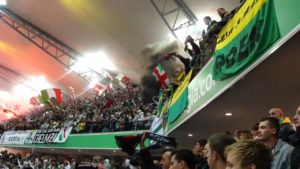Addirittura prima dell’inizio del XX secolo, in Inghilterra si utilizzava già la parola hooligans, termine ripreso in seguito da giornali del Tirolo al fine di definire i vandali che in zona depredavano piccoli paesi distrutti dalla Prima Guerra mondiale. Con il passare degli anni questo sostantivo divenne squisitamente britannico, ed indicò i riottosi che, durante manifestazioni calcistiche, creavano scompigli e rivalità con altre tifoserie. Azioni tipiche degli hooligans erano l’occupazione delle curve avversarie (facilitate dalla frequente comunanza di colori di squadre inglesi, quali il rosso, il blu ed il violetto), gli scontri fuori dallo stadio (che spesso hanno causato tragiche morti per mano di tifosi), o goliardiche invasioni di campo atte al dimostrare che non erano sufficienti i limiti imposti dalla Football Association a bordo campo durante quel periodo. Per combattere ed eliminare tutto ciò si necessitò dell’intervento della politica inglese, con Margaret Thatcher che si assunse il ruolo di “paladina della giustizia”, e prendendosi insulti su insulti dagli adepti al movimento casual, skinhead e mod, tutte filosofie vicine all’hooliganismo. Con il tempo la politica prevalse sulla passione della gente, ma è errato pensare che l’ondata sia del tutto terminata: il sentimento hooligan si manifesta in maniera differente, al giorno d’oggi, ed è necessario specificare che si è allargato in tutto il mondo calcistico, non rimanendo più una particolarità del Regno Unito. Polonia, Italia ed Olanda sono tra le nazioni più influenti al giorno d’oggi, ed è proprio su questi 3 paesi su cui questo articolo è incentrato: in particolare, andremo ad analizzare una sorta di gemellaggio, nato e cresciuto negli scorsi anni, tra Swansea, Juventus, ADO den Haag, Legia Varsavia e Club Brugge (squadra belga): cinque squadre tutte dotate di un tifo sfrenato.
L’alleanza ha origini nei lontani anni ’70 o ’80, e si basa su un gemellaggio tra ADO e Legia, le due tifoserie più influenti tra le cinque. Con il passare degli anni tutto ciò è divenuto comune anche ai media ed alla gente normale, trasformandosi da patto segreto di sangue, a vero e proprio accordo dichiarato. Ai nostri giorni non è una novità vedere articoli con marchio ADO den Haag in official store del Legia, o viceversa, a dimostrazione che questa amicizia ha ottenuto anche un reticolo commerciale. Ovviamente tutto ciò è deciso dalle dirigenze dei club: in mano alla gente resta la possibilità di cantare e tifare, per una volta, verso un obbiettivo comune e non contrario. E’ bello pensare che un movimento che anni fa partì proprio dalla curva, oggi (ormai da un po’ di tempo, a dirla tutta), abbia raggiunto le orecchie dei capi dei club. Basti pensare che ogni anno, o quasi, i cinque club che sono assorbiti in questa alleanza, si incontrano in un torneo amichevole, un qualcosa di impossibile senza l’autorizzazione comunale, o comunque da parte della società che possiede lo stadio in cui si giocherà, e che ha in mano le redini dell’organizzazione.
Torniamo ora all’analisi della mini-associazione tra queste tifoserie, e spieghiamo il motivo della presenza della Juventus in tutto ciò: i Viking, capi della curva bianco-nera, presa consapevolezza dell’odio nei loro confronti da parte di presso che ogni tifoseria italiana, decisero di auto-crearsi degli accordi all’estero. Inutile ricordare la partita tra Napoli e Legia Varsavia, in una delle scorse Europa League, dove gli hooligans polacchi maltrattarono il San Paolo proprio a causa di questo accordo con la Juventus. Casualità o meno, su questo non abbiamo conferme, la curva della squadra polacca è solita esporre il tricolore verde-bianco-rosso nell’esatto ordine di quello della bandiera italiana, ed in verticale, piuttosto che in obliquo come indica lo stemma del club. Più profonda, invece, l’amicizia con l’ADO den Haag: i tifosi giallo-verdi sono nemici giurati dell’Ajax, e probabilmente anche per qualche questione politica, la Juventus è amica fidata degli Zwanen.

Tra le cinque, il Club Brugge è indubbiamente la tifoseria meno attaccata alla causa: è vero, c’è una sorta di gemellaggio, ma i belgi non hanno mai desiderato stringere ulteriormente i rapporti, se non nel raro caso di una trasferta in casa di Swansea, Juventus, ADO o Legia. Molto particolare e carina, invece, la posizione dello Swansea in tutto ciò: come sempre i britannici ci tengono a rendere il tutto migliore, e bisogna dire che la squadra gallese sia riuscita nell’intento. Il fulcro di tutto ciò è John van Zweden (nella foto in basso), un imprenditore che ama il calcio, nato a den Haag ed ora co-proprietario proprio dello Swansea. Durante questo periodo, con lui in carica, l’amicizia tra i club ha raggiunto livelli molto alti e per certi versi indissolubili: le tifoserie sono ormai sorelle, anche se i gallesi restano piuttosto lontani dalle faccende di Club Bruges, Juventus e Legia Varsavia. Pensare che nell’anno della promozione in prima divisione dello Swansea, proprio van Zwenden, regalò ad un settore dei tifosi del den Haag ben 400 biglietti per la finale di Coppa di Lega, giocata a Wembley. Quel giorno, a Londra, oltre al bianco-nero degli Swans ed al granata del Bradford, ci fu anche una macchiolina verde-gialla, a dimostrazione dell’unione e della fedeltà tra questi club.

Oggi abbiamo provato a portarvi nelle viscere di questi particolari accordi tra ultras: come potete ben immaginare, questo quintetto non è l’unico nel mondo, e nemmeno in Europa. Il movimento degli hooligans sta trovando anno dopo anno vari spunti per ingrandirsi e migliorarsi, facendosi beffa di decisioni politiche. Fa piacere che ancora oggi si possa respirare in certi casi il profumo di vero calcio, uno sport che con tutte le difficoltà che incontrerà siamo sicuri che, almeno in parte, resterà sempre lo sport della gente. Le passioni, sono sempre incontrollabili, anche e sopratutto oltre il novantesimo.
_______________________________________________________________________
Un grande ringraziamento a VoetbalStadion, pagina di calcio olandese che ci ha aiutato nel passaggio di informazioni nella stesura di questo prezioso articolo:
https://www.instagram.com/voetbalstadionnet/
_______________________________________________________________________
ENGLISH TRANSLATION
Even before the start of the twentieth century, in England it was already used the word hooligans, a term taken up later by the newspapers of the Tyrol in order to define the vandals who preyed small towns destroyed by the Blitzkrieg, or the First World War. Over the years this noun became exquisitely British, and pointed to the rioters that during football events, created upheavals and rivalries with other fans. Typical actions of hooligans were the occupation of opposing curves (facilitated by frequent color commonality of English teams, such as red, blue and violet), the clashes outside the stadium (which often resulted in tragic deaths) or goliardic pitch invasions aimed to show that the limits imposed by the Football Association on the sideline during that period weren’t enough. To combat and eliminate all this necessitated the intervention of British politics, with Margaret Thatcher took on the role of “champion of justice”, and taking insults by members of a casual movement, skinheads and mods, all close hooliganism’s philosophies. By the time the policy prevailed on the passion of the people, but it is wrong to think that the wave is completely finished: the hooligan sentiment is manifested in different ways, nowadays, and has expanded all over the football world, no longer remaining a UK special. Poland, Italy and the Netherlands are among the most influential nations nowadays, and it is on these three countries on which this article focuses: in particular, we analyze a sort of twinning, born and raised in past years, including Swansea, Juventus, ADO den Haag, Legia Warsaw and Club Brugge (from Belgium): five teams all have a wild cheering.

The alliance has origins back in the 70s or 80s, and is based on a partnership between ADO and Legia, the two most influential supporters among the five. Over the years everything has become common also to the media and the ordinary people, turning from a secret pact of blood, to a real agreement stated. Nowadays it isn’t new to see ADO den Haag’s brand in the official store of Legia, or vice versa, demonstrating that this friendship has also obtained a commercial network. Obviously everything is decided by the club leaderships: in the hands of the people remains the chance to sing and cheer, for once, toward a common goal and not the contrary. It ‘nice to think that a movement that years ago set off right from the curve, today (now a bit’ of time, to be honest), has reached the ears of club leaders. Just think that every year, or nearly so, the five clubs that are absorbed in this alliance, meet in a friendly tournament, something impossible without the municipal approval, or otherwise from the company that owns the stadium where you play and who holds the reins of the organization.
Lets return to the analysis of the association between these mini-associations, and we explain why the presence of Juventus in everything: the Drug, leaders of the white-black curve, taking awareness of hatred towards them by at every fans Italian, decided to self-create some foreign agreements. Needless to mention the match between Napoli and Legia Warsaw, in one of the recent Europa League, where Polish hooligans mistreated the San Paolo precisely because of this agreement with Juventus. Coincidence or not, we have no confirmation of this, the curve of the Polish team is accustomed to expose the green-white-red flag in the exact order as that of the Italian flag, and vertically, rather than at an angle as indicated by the club crest. Deeper, however, friendship with the ADO den Haag: yellow-green supporters are sworn enemies of Ajax, and probably also for some political issue, Juventus is trusted friend of the Zwanen.

Among the five, Club Brugge is undoubtedly the fans less attached to the cause: it is true, there is a sort of twinning, but the Belgians have never wanted to further tighten the relationship, except in the rare case of a trip to the home of Swansea, Juventus, ADO or Legia. Very unique and pretty, however, the position of Swansea in everything: as usual the British are keen to make things better, and we must say that the Welsh team has succeeded in. The focus of this is John van Zweden (pictured below), a businessman who loves football, born in den Haag and now co-owner of their Swansea. During this time, with him in charge, the friendship between the club reached a very high level and in some ways inseparable: the fans are now sisters, although the Welsh remain rather far from the chores of Club Bruges, Juventus and Legia Warsaw. To think that in the year of promotion to first division of Swansea, van Zwenden, gave to a sector of fans of den Haag 400 tickets for the final of the League Cup, played at Wembley. That day, in London, in addition to black and white Swans and the grenade Bradford, there was also a green-yellow speckle, a union demonstration and fidelity between these clubs.

Today we tried to bring in the bowels of these particular agreements between ultras: as you can imagine, this quintet is not the only one in the world, and even in Europe. The movement of hooligans is finding year after year various ideas for getting bigger and better, making a mockery of political decisions. It is glad that even today you can breathe the scent of real football in some cases, a sport with all the difficulties we encounter we are sure that, at least in part, will always be the sport of the people. The passions are always uncontrollable, even over and above the 90 minutes.
_______________________________________________________________________
Massive thank you to VoetbalStadion, Dutch football page that helped us in the passing information in writing this valuable article:
https://www.instagram.com/voetbalstadionnet/
